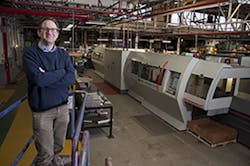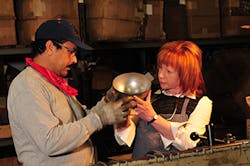Steely resolve: How U.S. manufacturers that rely on imported metals are coping with tariffs
In this article:
- Mitigating costs with production efficiency and retooling
- Relocating and sourcing options
- Net loss of jobs forecasted
For U.S. manufacturers caught in the tariff exchange, one thing is certain: There is a lot of instability in industrial markets. Manufacturers are contending with is a 25% tariff on steel, a 10% tariff on aluminum and other metals imported from all countries except Australia, South Korea, Argentina, and Brazil, as well as retaliatory tariffs from trading partners.
“Our cost structure has changed overnight,” says Craig Freedman, CEO of Freedman Seating, a $100 million company whose transportation seating products are one-third steel.
The tariffs’ stated objectives were to hasten the U.S. production of the taxed imports to create more jobs in the United States, to stimulate the domestic economy, and to protect national security. President Donald Trump’s administration particularly has designs on China to cut the $375 billion trade deficit and to use the tariffs as leverage to negotiate the U.S. Mexico-Canada Agreement, or USMCA, which is now signed but yet to be approved by Congress.
This was the combined vision for the tariffs, which have become a bad dream for many companies that consume a lot of steel, aluminum, and other metals. At least 21,000 companies have requested tariff exclusions, and many manufacturers have announced changes in their business in reaction to their increased costs. Industrial manufacturers of all sizes, with revenues in the tens of millions to hundreds of millions, are rising to the challenges of the volatile market. Those challenges are fraught with anguish.
“Our cost structure has changed overnight,” says Craig Freedman, CEO of Freedman Seating, a $100 million company whose transportation seating products are composed of one-third steel. “With the 25% tariff on steel, the U.S. prices are now orbiting somewhere between 25% to 50% or higher. There is great pain and stress in the industry, and our company has barely weathered this. It is hard to keep the margins. Smaller companies have gone out of business.”
Mitigating costs with production efficiency and retooling
Freedman said they are doing what they can in the short term to mitigate the cost increases.
“We are looking for ways to be more efficient,” he says. “However, we are already quite streamlined, so we did not significantly bring down our costs.” Rather, he says: “We bear it. It would take years to redesign, retool an alternative metal that would meet U.S. safety standards.”
Like Freedman, Ergoseal, a company that creates metal seals primarily from stainless steel, was already investing in production efficiencies and retooling when 2018 brought a 70% increase in steel and other metals, cutting deep into the company’s margins.
“In order to retool you have to have a stable, consistent source of steel,” says Tom Hilaris, president and CEO of Ergoseal. “We began by looking at our sources of steel. We typically went with the lowest price through non-European sources outside the U.S., and there were often inconsistencies in the raw material. But to be more efficient and to manufacture faster, we needed better raw material. We found that the U.S. and European mills had better predictability.”
“There is no doubt the quality is more consistent from the U.S. mills,” agrees Sandy Westlund-Deenihan, president and design engineer of Quality Float Works, a manufacturer of metal float balls, valves, and assemblies for the oil, gas, plumbing, and agricultural industries. Over the company’s 104-year history, it had already sourced much of its steel from the United States and has learned to adjust to fluctuations in the market.
“In our many years in business, we have ridden many surcharges on metals, and particularly in the last 20 to 30 years, have learned to streamline,” asserts Westlund-Deenihan. “We expected prices to go up [with the tariffs], and we continue to rely on our loyal customer base.”
“We believe in the ‘Buy American’ objective,” says Westlund-Deenihan, who sits on the boards of the National Association of Manufacturers and the Illinois Manufacturers’ Association. Yet Westlund-Deenihan admits that she has had tough conversations with customers about the market volatility. Now that her suppliers have dropped prices for domestic steel about 30%, she’s feeling better but says she still has concerns.
Referencing reports of U.S. mills expanding capacity and U.S. Steel’s plans to revitalize its plants in southern Illinois and in Gary, IN, Westlund-Deenihan asks: “How long will it take to ramp up a facility? How long will it take to build more mills?” She adds: “This is not a short-term proposition, and we need the materials now.”
Some U.S. steel mills’ reported plans to increase production capacity and reinvigorate facilities “is not a short-term proposition, and we need the materials now,” says Sandy Westlund-Deenihan, president and design engineer of Quality Float Works, pictured here with Enrique Zavala.
Relocating and sourcing options
In the fluid world of trade, companies use creative sourcing to reduce costs and gain flexibility.
“We engineer in Detroit and Europe, send the components to Mexico, assemble in China,” explains John Winziler, president of Winziler Gear. “We ship our gears for small motors primarily to Germany, Austria, Switzerland.”
If a company sells all over the world, one option, of course, is to move a plant to a location nearer a large number of customers. For example, Ergoseal purchases many of its components from Asia. It imports tungsten carbide from China, the only source in the world for the material beyond Russia. Because Ergoseal exports a large number of products to Europe, the plan is to locate a primary plant there, thus avoiding additional shipping and tariff costs.
Adding or relocating a plant is expensive and not easy, particularly for a $10 million company such as Ergoseal. However, Ergoseal’s Hilaris notes: “If I’m too expensive by passing on my increased costs to my customers, it opens the door for my competition. I need to make sure I maintain my customers and my profitability.”
Some companies see few options other than to stay with their current sources in China. With only 10% tariff on the tooling his company requires, “It is still worth fabricating in China,” says Skip Glatt, an inventor and president of Gaim Plastics, a company that originated in 1989 using recycled resins for injection molding OEM and consumer retail products. Besides, Glatt says, he doesn’t have many choices in the United States.
“At one time there were nine good sources for injection molds just around the corner from where my headquarters is based,” explains Glatt. “Now there are only two one-person outfits nearby and the others I randomly find, like a guy on the airplane or a referral to another one-person shop in a nearby town.”
Glatt adds, “If we bought the injection molding machines in China instead of just tooling there, we’d get clobbered with high tariffs, but then we’d switch to Korea and Taiwan.”
Net loss of jobs forecasted
Freedman Seating, Winziler Gear, Gaim Engineering, Quality Float Works, and Ergoseal all are addressing market changes short of raising prices or cutting jobs. As many manufacturers, they are optimistic, hoping for a yielding or softening on the tariffs.
Deanna Nord, owner of Nord Strategy Group, is a writer, public speaker, and creative strategist. Contact her at [email protected].
Still, many companies are making difficult choices to increase their prices, and the costs of the tariffs spreads to business customers and consumers. Others would lose business to foreign competitors if they raise prices. Some companies had no choice but to cut jobs or move production. Harley-Davidson moved some production to Thailand to serve its growing market in Europe. To offset $35 million in tariff-related costs, Stanley Black & Decker, the tool and hardware company, is now going to suppliers outside the United States.
According to a study by The Trade Partnership, the steel and aluminum tariffs could result in a loss of more than 400,000 U.S. jobs among the estimated 6.5 million employees in all industries using steel – transportation, agriculture, energy, defense, medical devices, and many others.
Within that number, the Trade Partnership predicts 19,000 will be lost in manufacturing. To compare, when steel tariffs were imposed in 2002, there were about 200,000 job cuts. The Trade Partnership forecasts a gain of a modest 23,000 jobs within U.S. iron and steel manufacturers.
There is also concern about decreased innovation in the current trade environment. “Companies always need to drive innovation, to invest in research and development.” Hilaris of Ergoseal says. “The increased costs due to tariffs could cause some companies to cut back on research and development or to go into a holding pattern on reinvesting in innovation and improvements.”
One area expected to see more investment is the global robotics and automation market, projected to reach $237 billion in 2022 from $31 billion in 2016, according to Tractica. The tariffs could shorten that timeline exponentially. The increased drive for efficiencies will help propel advances in the smart factory model, further automating manufacturing processes.
Companies such as Rockwell Automation in the United States, KUKA AG in Germany and FANUC, a Japanese company, are investing heavily in the automation sector. As statistics show, greater productivity in the manufacturing sector can lead to lower prices, higher demand for products, and more jobs.
“Not only does manufacturing provide high value-added jobs, often in places that need them,” wrote economist Jared Bernstein, a senior fellow at the Center for Budget and Policy Priorities, in a July 2018 Washington Post editorial, “but it punches above its weight in R&D and has positive spillovers to other sectors.”


